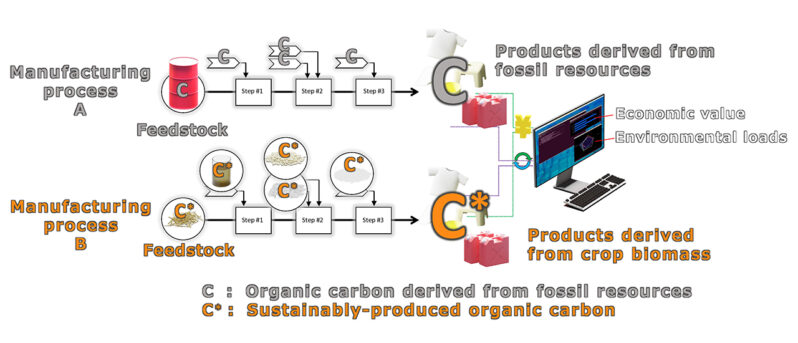SubjectⅠ
Development of Super DAC rice with enhanced CO2 absorption and fixation capacity
Goals
We aim to develop “Super DAC rice”, which has extremely high CO2 absorption and fixation capacity. To achieve this, we will make gene modifications using genome-editing technology, with particular attention to genes related to the photosynthetic capacity of leaves, nutrient absorption capacity of roots, and sink capacity determined by the number and size of seeds.
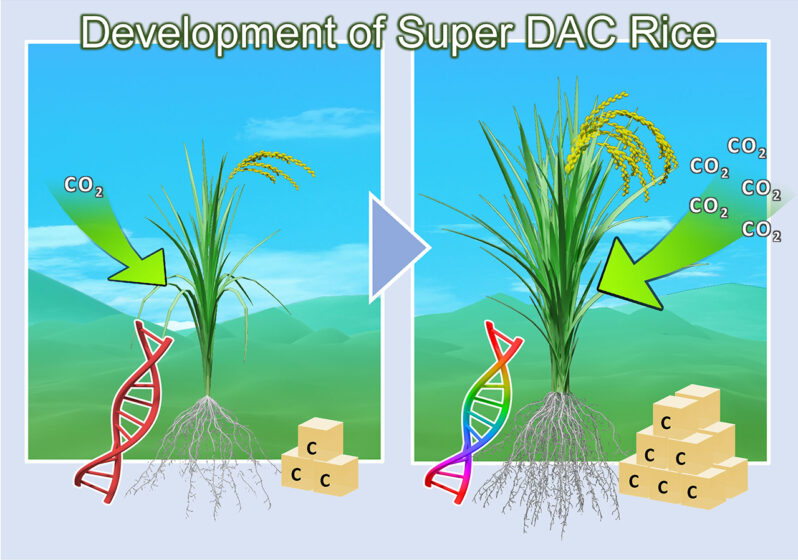
Research Contents
Rice is one of the most important crops in the world. It is cultivated on over 160 million hectares worldwide and used as a staple food for half the world’s population. Although rice plants absorb a vast amount of CO2 annually, the current uses of their grains and straw are insufficient to contribute to decarbonization of the atmosphere. To use rice grains and straw as a more effective CO2 fixing agent, and to reduce the collection and processing costs, it is necessary to dramatically improve CO2 absorption and fixation capacity through photosynthesis, storage capacity for fixed carbon, and utilization efficiency of stored carbon.
In this project, we are developing new rice breeding materials with improved DAC properties (CO2 absorption/fixation capacity, carbon storage capacity, and carbon utilization efficiency). We use “Hokuriku 193”, one of the highest yielding varieties in Japan, as the original variety and apply genome-editing technology to introduce mutations into multiple genes to improve DAC properties.
- Improving the capacity of leaf photosynthesis and nutrient absorption by the roots (source capacity) by genome editing.
- Enhancing the number of seeds and seed size (sink capacity) by genome editing and DNA marker-assisted selection.
- Improving utilization efficiency of carbon in starch and cellulose by changing the molecular structure and amounts stored through genome editing.
- Developing rice plants with modified source and sink capacities at the same time through crossing and speed breeding, and evaluating their DAC properties.
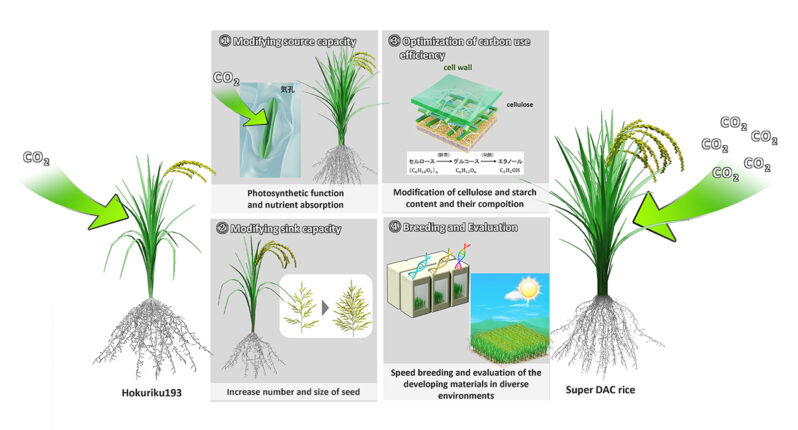
Subject Ⅱ
Research on carbon fixation by increasing crop biomass
Goals
Using C4 crops (maize and sorghum) and their related wild species, which possess exceptional CO2 absorption abilities, we aim to breed hybrid lines with significantly augmented biomass to positively impact carbon fixation. Because agricultural soils play a crucial role in stocking carbon, we will in parallel assess the carbon storage in soils where the new crops are grown and identify crop features that might optimize its storage potential.
Research Contents
- To enhance the CO2 absorption and utilization potential of maize and sorghum, we develop technology to increase the amount of their above-ground (maize) and below-ground (sorghum) biomass using hybrid vigor to exploit the genomes of related wild species.
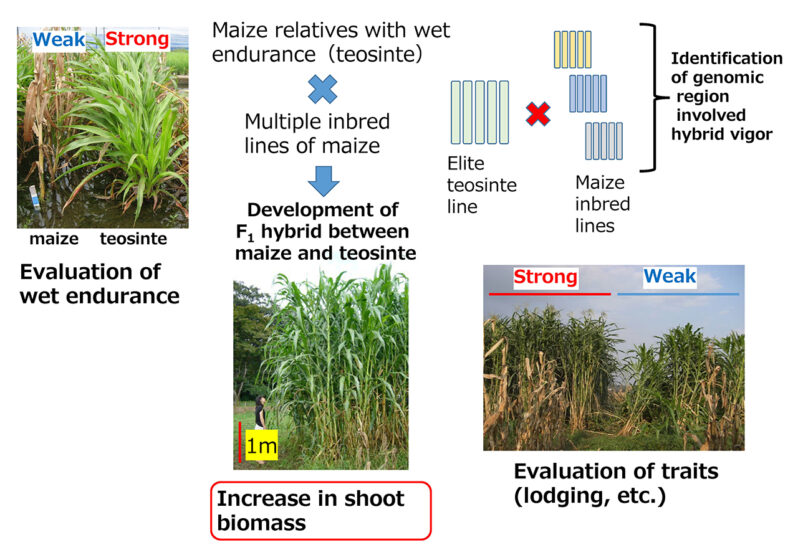
- To quantify the carbon sequestered in soil used for growing a crop, we study how soil carbon changes over time and how crop residues (such as roots and stems in the ground) help to lock away carbon. Using this knowledge, we construct a computer model of soil carbon dynamics to help predict the long-term trends in soil carbon.
- We use the crop data to assess the CO2 absorption potential of the breeding materials, using tools that help visualize the interactions between genetic effects and environmental factors.
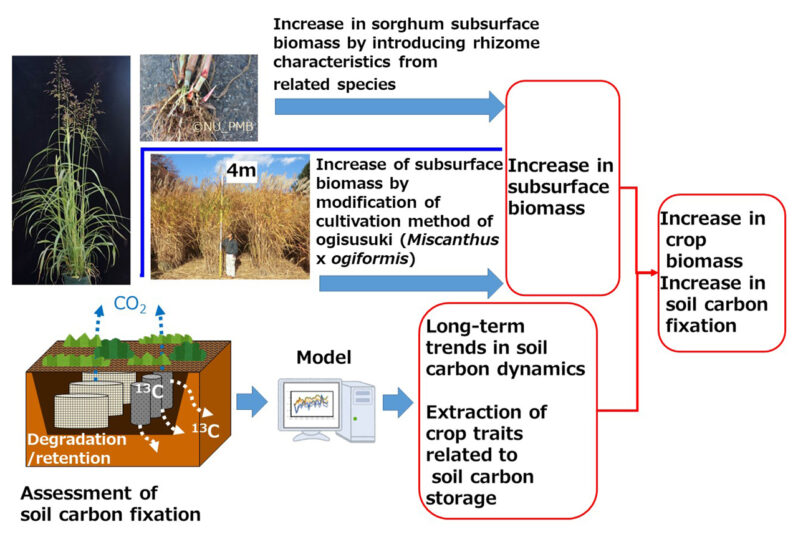
Subject Ⅲ
Evaluation of economic value and environmental load of resource utilization process in DAC agriculture
Goals
The carbon efficiently fixed by Super DAC crops can be recovered mainly in the above-ground parts (i.e., grains and foliage). We will investigate and analyze methods for converting these resources into valuable industrial products (based on sugars and plant fibers) and creating sustainable industries that can contribute to removing large amounts of CO2 from the atmosphere.
Research Contents
- We evaluate the economic value and environmental impact of processes from the production stage of Super DAC crops to the recovery and use of fermentable sugars (glucose, etc.) and/or fiber materials.
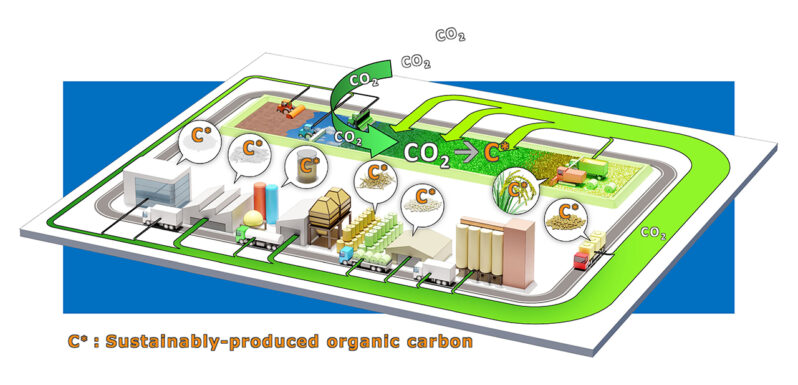
- Using evaluation data on the material and conversion properties of crops, we assess the possibility of manufacturing sugar-based products and/or new materials with high added value, and formulate supply chains that can be commercialized.
